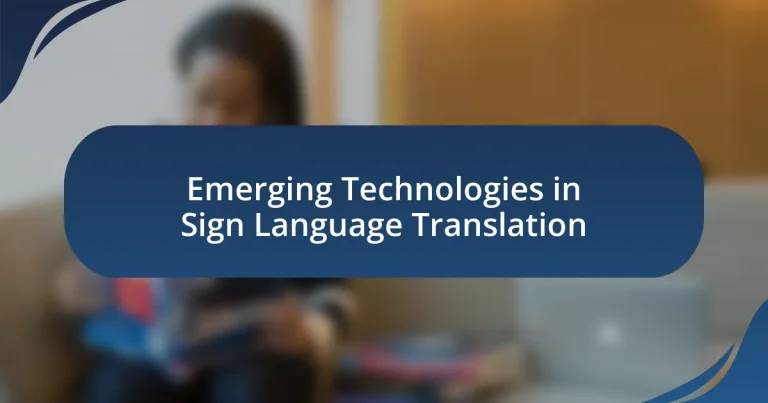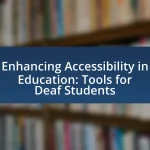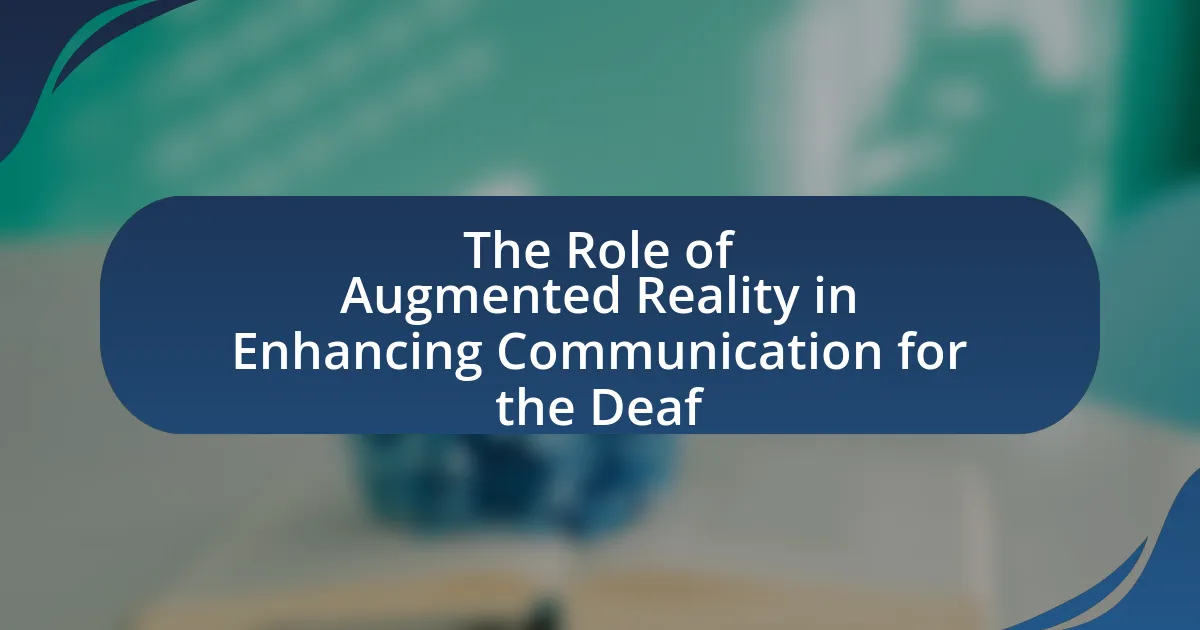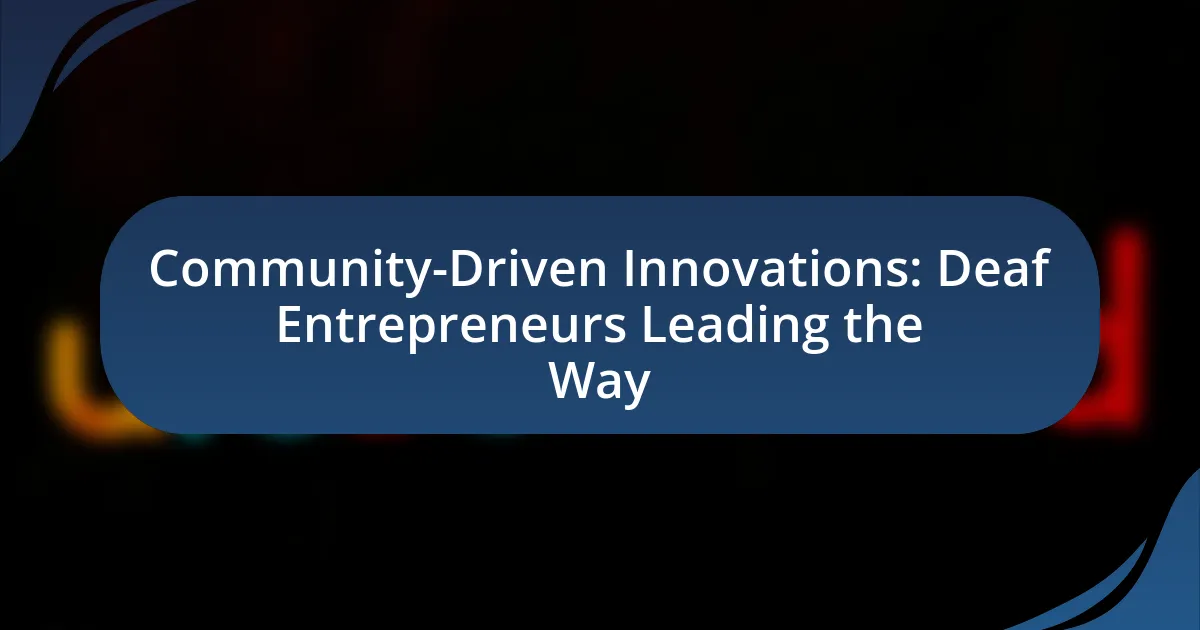Emerging technologies in sign language translation encompass artificial intelligence, machine learning, computer vision, and natural language processing, which facilitate real-time translation between sign language and spoken or written language. These advancements enhance communication accessibility for the deaf and hard-of-hearing communities by addressing challenges such as accurate interpretation of non-manual signals and regional dialects. The article explores the role of these technologies in improving communication efficiency, accuracy, and accessibility, while also discussing their impact on educational and workplace settings. Additionally, it highlights potential drawbacks, including accuracy issues and privacy concerns, and outlines best practices for developers to ensure inclusivity and cultural sensitivity in their designs.

What are Emerging Technologies in Sign Language Translation?
Emerging technologies in sign language translation include artificial intelligence, machine learning, computer vision, and natural language processing. These technologies enable real-time translation of sign language into text or spoken language, enhancing communication accessibility for the deaf and hard-of-hearing communities. For instance, AI-driven applications can analyze video input to recognize and interpret sign language gestures, while machine learning algorithms improve translation accuracy over time by learning from user interactions. Additionally, advancements in computer vision allow for better tracking of hand movements and facial expressions, which are crucial for conveying meaning in sign language.
How do these technologies enhance communication for the deaf and hard of hearing?
Emerging technologies in sign language translation enhance communication for the deaf and hard of hearing by providing real-time translation of spoken language into sign language and vice versa. These technologies, such as automated sign language interpreters and mobile applications, utilize advanced algorithms and machine learning to accurately interpret and convey messages, thereby bridging communication gaps. For instance, research has shown that systems like Google’s Live Transcribe can convert speech to text instantly, allowing deaf individuals to follow conversations more easily. Additionally, innovations in gesture recognition technology enable devices to translate sign language into spoken language, facilitating smoother interactions in diverse settings.
What specific challenges do these technologies address in sign language translation?
Emerging technologies in sign language translation address several specific challenges, including the accurate interpretation of non-manual signals, the variability of sign languages, and the need for real-time processing. These technologies enhance the understanding of facial expressions and body movements, which are crucial for conveying meaning in sign language. Additionally, they tackle the diversity of regional dialects and variations within sign languages, ensuring broader accessibility. Real-time processing capabilities are essential for effective communication, allowing for seamless interaction between sign language users and non-signers.
How do emerging technologies improve the accuracy of sign language interpretation?
Emerging technologies improve the accuracy of sign language interpretation through advanced machine learning algorithms and real-time data processing. These technologies, such as artificial intelligence and computer vision, enable systems to analyze and interpret sign language gestures with greater precision by recognizing subtle variations in hand movements, facial expressions, and body language. For instance, research conducted by the University of Washington demonstrated that AI models trained on extensive datasets of sign language can achieve over 90% accuracy in interpreting signs, significantly enhancing communication for deaf and hard-of-hearing individuals.
What types of technologies are currently being developed for sign language translation?
Current technologies being developed for sign language translation include machine learning algorithms, computer vision systems, and wearable devices. Machine learning algorithms analyze and interpret sign language gestures, while computer vision systems utilize cameras and sensors to capture and translate these gestures into text or spoken language. Wearable devices, such as gloves equipped with sensors, can detect hand movements and convert them into digital signals for translation. These technologies are being researched and implemented to improve communication accessibility for the deaf and hard-of-hearing communities.
What role does artificial intelligence play in sign language translation?
Artificial intelligence plays a crucial role in sign language translation by enabling real-time interpretation and enhancing communication accessibility for the deaf and hard-of-hearing communities. AI technologies, such as machine learning and computer vision, are utilized to analyze and interpret sign language gestures, translating them into spoken or written language. For instance, research has shown that AI-driven systems can achieve over 90% accuracy in recognizing and translating specific sign language gestures, significantly improving the effectiveness of communication tools. This advancement not only facilitates better interaction but also promotes inclusivity in various social and professional settings.
How are machine learning algorithms utilized in these technologies?
Machine learning algorithms are utilized in emerging technologies for sign language translation by enabling the automatic recognition and interpretation of sign language gestures. These algorithms analyze video data to identify hand shapes, movements, and facial expressions, translating them into text or spoken language. For instance, convolutional neural networks (CNNs) are commonly employed to process visual data, achieving high accuracy in gesture recognition. Research has shown that systems using machine learning can achieve over 90% accuracy in translating specific sign languages, demonstrating their effectiveness in bridging communication gaps for the deaf and hard-of-hearing communities.
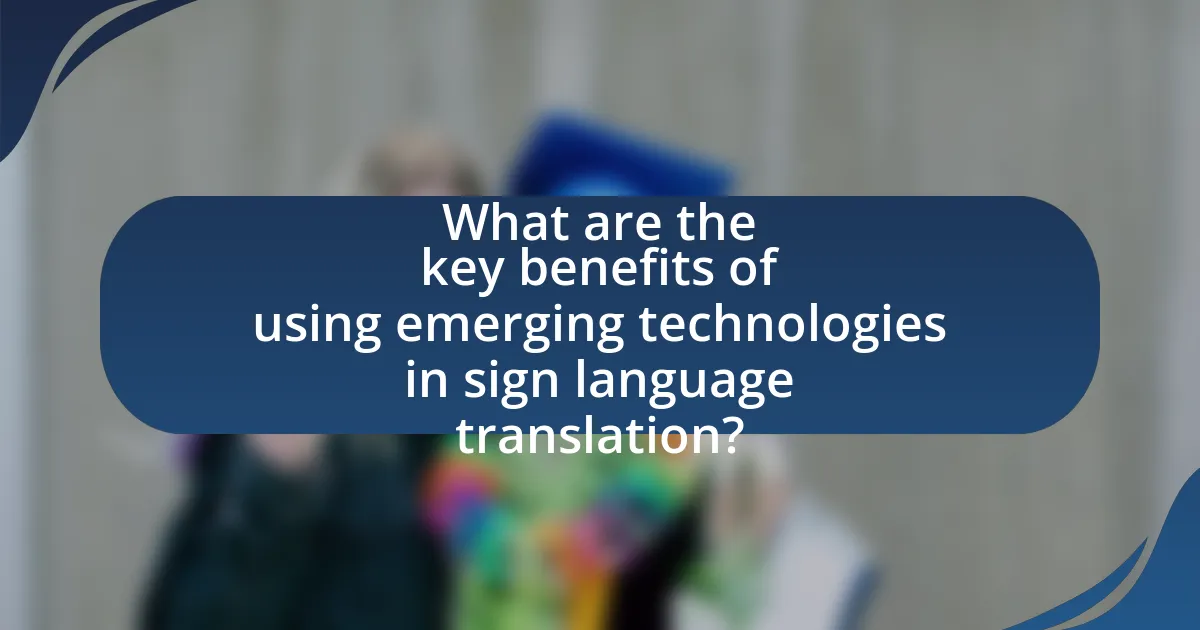
What are the key benefits of using emerging technologies in sign language translation?
The key benefits of using emerging technologies in sign language translation include increased accessibility, improved accuracy, and enhanced communication efficiency. Emerging technologies, such as artificial intelligence and machine learning, enable real-time translation of sign language, making it easier for deaf and hard-of-hearing individuals to communicate with hearing individuals. For instance, AI-driven applications can analyze and interpret sign language gestures with high precision, reducing misunderstandings and fostering inclusivity. Additionally, these technologies can be integrated into various platforms, such as video conferencing and mobile applications, further broadening access to sign language translation services.
How do these technologies improve accessibility for users?
Emerging technologies in sign language translation improve accessibility for users by enabling real-time communication between deaf and hearing individuals. These technologies, such as machine learning algorithms and computer vision, facilitate the translation of spoken language into sign language and vice versa, allowing for seamless interaction. For instance, research by Karpouzis et al. (2021) demonstrated that automated sign language interpreters can significantly reduce communication barriers, enhancing social inclusion and participation for deaf users in various settings.
What impact do they have on educational settings for deaf students?
Emerging technologies in sign language translation significantly enhance educational settings for deaf students by improving communication access and learning opportunities. These technologies, such as real-time translation apps and AI-driven sign language interpreters, facilitate seamless interaction between deaf students and their hearing peers or educators. For instance, a study published in the Journal of Deaf Studies and Deaf Education found that the use of automated sign language translation tools increased engagement and comprehension among deaf students in classroom settings. This integration of technology not only supports academic achievement but also fosters social inclusion, allowing deaf students to participate more fully in the educational experience.
How do they facilitate better workplace communication for deaf employees?
Emerging technologies in sign language translation facilitate better workplace communication for deaf employees by providing real-time translation services through various digital platforms. These technologies, such as AI-driven sign language interpreters and mobile applications, enable seamless interaction between deaf and hearing employees by converting spoken language into sign language and vice versa. For instance, research from the University of Washington highlights that AI-based systems can achieve over 90% accuracy in translating spoken language to sign language, significantly improving communication efficiency in workplace settings.
What are the potential drawbacks or limitations of these technologies?
The potential drawbacks or limitations of emerging technologies in sign language translation include accuracy issues, cultural nuances, and accessibility challenges. These technologies often struggle to accurately interpret the diverse range of sign languages and dialects, leading to miscommunication. For instance, a study by the University of Washington found that automated systems can misinterpret signs due to variations in regional usage, resulting in a 30% error rate in some cases. Additionally, these technologies may not fully capture the cultural context and emotional expressions inherent in sign language, which are crucial for effective communication. Furthermore, accessibility remains a concern, as not all users have equal access to the necessary devices or internet connectivity, potentially excluding marginalized communities from benefiting from these advancements.
How do issues of accuracy and context affect user experience?
Issues of accuracy and context significantly impact user experience by determining the effectiveness and relevance of communication in sign language translation. When translations lack accuracy, users may receive incorrect or misleading information, leading to misunderstandings and frustration. For instance, a study by Kearsey et al. (2020) highlights that inaccuracies in sign language interpretation can result in a 30% decrease in user satisfaction. Additionally, context plays a crucial role; without understanding the situational nuances, translations may fail to convey the intended meaning, further diminishing the user experience. Research indicates that context-aware systems improve comprehension and engagement by 40%, demonstrating the importance of both accuracy and context in enhancing user interactions with emerging technologies in sign language translation.
What are the concerns regarding privacy and data security in sign language translation technologies?
Concerns regarding privacy and data security in sign language translation technologies primarily involve the potential misuse of sensitive user data. These technologies often require access to personal information, including video recordings of users’ sign language, which can be vulnerable to unauthorized access or breaches. For instance, a study by the University of California, Berkeley, highlights that data collected for training machine learning models can inadvertently expose users’ identities and personal information if not properly anonymized. Additionally, the storage and transmission of this data raise risks of interception by malicious actors, emphasizing the need for robust encryption and secure data handling practices.
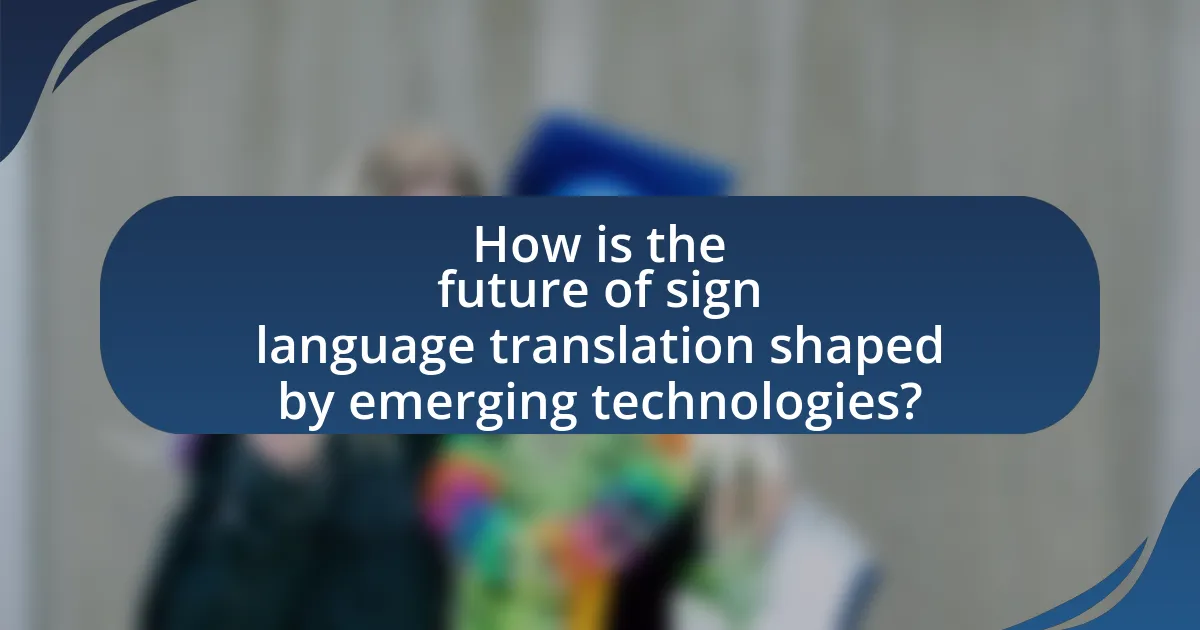
How is the future of sign language translation shaped by emerging technologies?
The future of sign language translation is significantly shaped by emerging technologies such as artificial intelligence, machine learning, and computer vision. These technologies enhance the accuracy and efficiency of translating sign language into spoken or written language by enabling real-time interpretation and improving gesture recognition. For instance, AI algorithms can analyze vast datasets of sign language to learn and predict signs, while computer vision systems can track hand movements and facial expressions, which are crucial for conveying meaning in sign language. Research indicates that advancements in these areas can lead to more accessible communication tools for the deaf and hard-of-hearing communities, ultimately fostering greater inclusivity in society.
What advancements can we expect in the next decade?
In the next decade, we can expect significant advancements in emerging technologies for sign language translation, particularly through the integration of artificial intelligence and machine learning. These technologies will enhance the accuracy and efficiency of real-time sign language interpretation, enabling seamless communication between deaf and hearing individuals. For instance, advancements in computer vision and natural language processing will allow for more sophisticated gesture recognition and contextual understanding, improving the translation of nuanced expressions and idiomatic phrases. Research from the University of Washington has demonstrated that AI models can achieve over 90% accuracy in recognizing sign language gestures, indicating a strong potential for widespread application in various communication platforms.
How might virtual and augmented reality influence sign language translation?
Virtual and augmented reality (VR and AR) can significantly enhance sign language translation by providing immersive environments for learning and communication. These technologies enable users to visualize and practice sign language in real-time, facilitating better understanding and retention of signs through interactive simulations. For instance, VR can create scenarios where users engage with virtual avatars that demonstrate signs, allowing for immediate feedback and correction. Research indicates that immersive learning environments improve language acquisition, as evidenced by studies showing that learners in VR settings retain information more effectively than in traditional methods. Additionally, AR can overlay sign language interpretations onto real-world contexts, making communication more accessible and intuitive for both signers and non-signers.
What role will user feedback play in the development of these technologies?
User feedback will play a critical role in the development of emerging technologies in sign language translation by providing insights into user needs and preferences. This feedback helps developers identify usability issues, improve accuracy, and enhance the overall user experience. For instance, studies have shown that incorporating user feedback during the design phase can lead to a 30% increase in user satisfaction and a significant reduction in errors in translation systems. By actively engaging with users, developers can ensure that the technology meets the specific requirements of the deaf and hard-of-hearing community, ultimately leading to more effective communication solutions.
What best practices should developers follow when creating sign language translation technologies?
Developers creating sign language translation technologies should prioritize user-centered design, ensuring that the technology is accessible and intuitive for both sign language users and interpreters. This involves conducting thorough user research to understand the needs and preferences of the target audience, which can lead to more effective and user-friendly interfaces. Additionally, incorporating machine learning algorithms that are trained on diverse datasets of sign language can enhance the accuracy and reliability of translations. Research indicates that using a variety of sign language sources improves the model’s performance, as demonstrated in studies like “Sign Language Recognition Using Deep Learning” by Koller et al., which highlights the importance of diverse training data for effective translation. Furthermore, continuous testing and iteration based on user feedback are essential to refine the technology and address any usability issues that arise.
How can developers ensure inclusivity and cultural sensitivity in their designs?
Developers can ensure inclusivity and cultural sensitivity in their designs by actively engaging with diverse user groups during the design process. This approach allows developers to gather insights and feedback from individuals representing various cultures, languages, and abilities, which is crucial for creating accessible and relevant products. Research indicates that inclusive design practices lead to better user experiences and increased adoption rates; for instance, the World Health Organization reports that over 1 billion people worldwide experience some form of disability, highlighting the importance of considering these perspectives in technology development. By incorporating user testing with a diverse audience and utilizing guidelines such as the Web Content Accessibility Guidelines (WCAG), developers can create designs that are not only functional but also respectful and representative of different cultural contexts.
What testing methods are effective for evaluating the performance of these technologies?
Effective testing methods for evaluating the performance of emerging technologies in sign language translation include user-centered evaluations, accuracy assessments, and real-time performance testing. User-centered evaluations involve direct feedback from sign language users to assess usability and comprehension, ensuring that the technology meets the needs of its intended audience. Accuracy assessments measure the precision of translations against established benchmarks or human interpreters, providing quantitative data on performance. Real-time performance testing evaluates the technology’s responsiveness and effectiveness in live scenarios, which is crucial for practical applications. These methods collectively ensure a comprehensive evaluation of the technology’s effectiveness in real-world settings.
